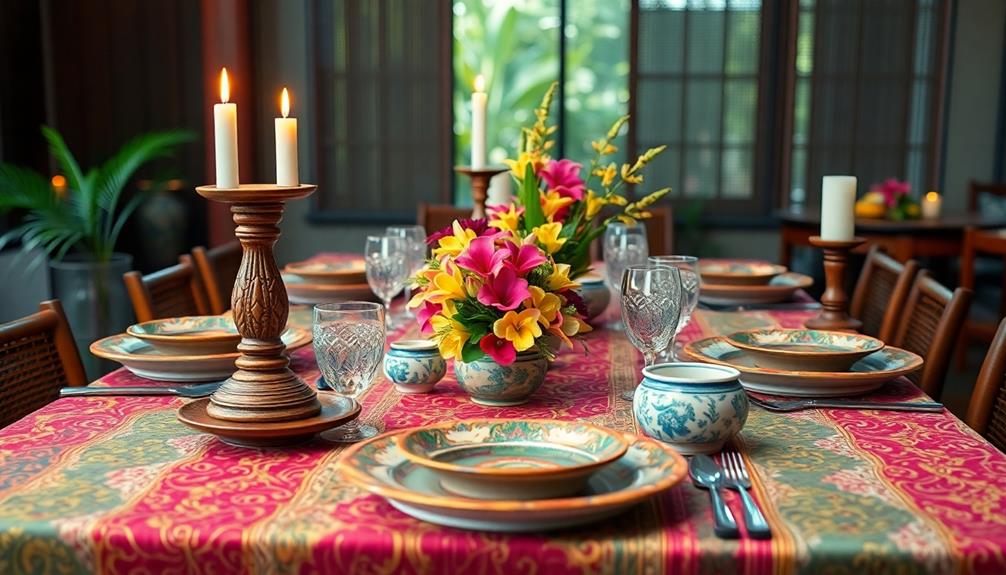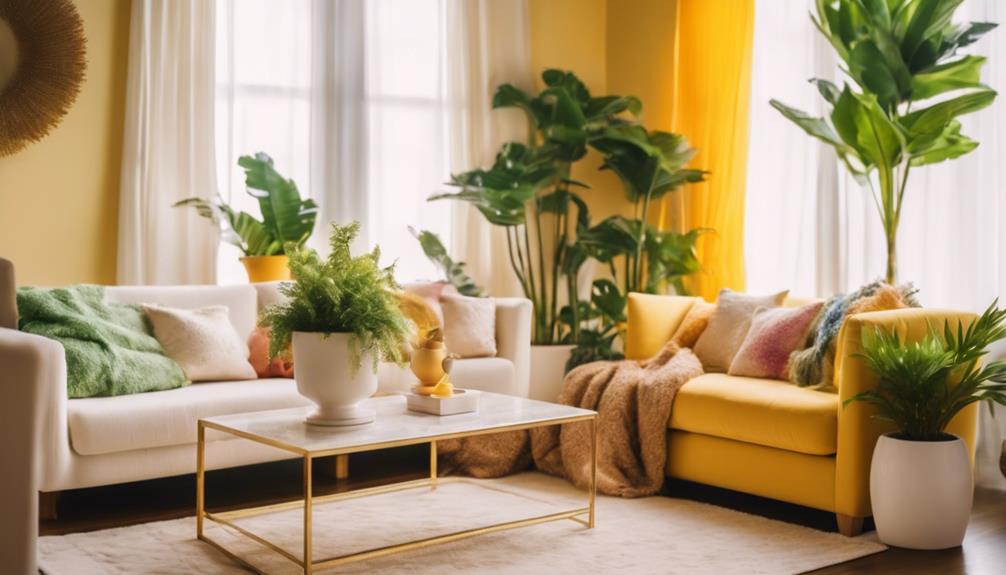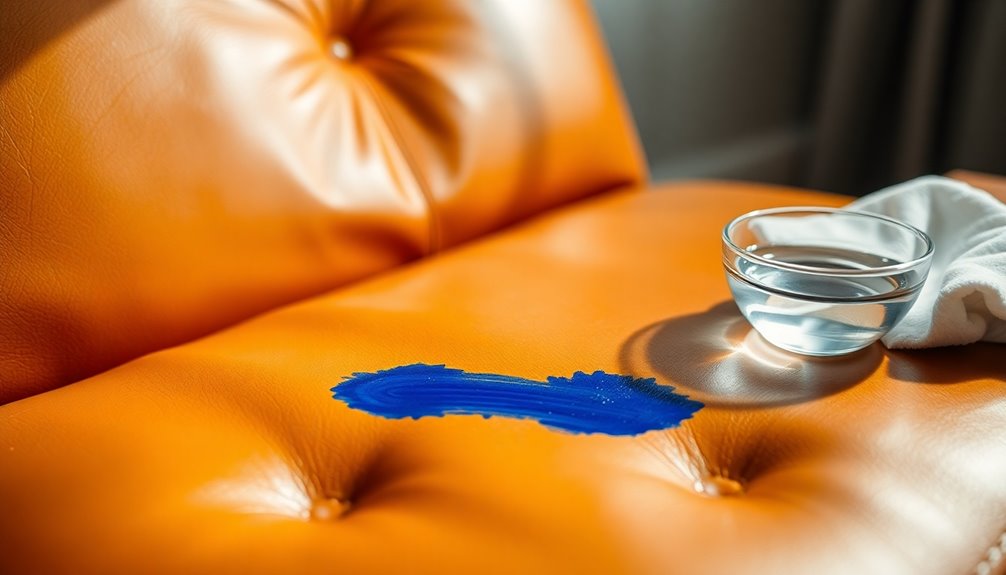To create the perfect Indonesian table setting, incorporate vibrant cultural elements and sustainable materials. Begin by using batik tablecloths and handcrafted ceramics that highlight unique artistry. Add eco-friendly placemats made from jute or rattan for a textural element. Colorful coasters crafted from bamboo can not only add to your decor but also protect your surfaces. For a touch of tradition, consider incorporating rustic wooden pieces and striking centerpieces. Elevate the look with aquamarine napkin rings for a touch of elegance. These thoughtful choices honor Indonesian heritage and will ensure a memorable dining experience. Explore more ways to enhance your table decor and celebrate this beautiful culture!
Key Takeaways
- Incorporate vibrant batik fabric for tablecloths and napkins to reflect traditional Indonesian artistry and add unique flair to your dining aesthetics.
- Use eco-friendly materials like bamboo and rattan for placemats and coasters to minimize ecological footprint while enhancing your table's visual appeal.
- Include handcrafted ceramics and pottery to elevate your dining experience with unique pieces that showcase cultural significance and artisanal craftsmanship.
- Utilize rustic furniture elements, such as handmade tables and natural materials, to create a warm and inviting atmosphere for your dining setting.
- Add decorative accessories like Indonesian decor masks and colorful napkin rings to connect with cultural identity and enrich the overall dining experience.
Cultural Significance of Indonesian Decor

When you explore Indonesian table decor, you'll quickly notice how deeply it reflects the country's rich cultural heritage. Each piece showcases local craftsmanship, making every gathering a celebration of tradition.
You'll find that materials like bamboo, batik fabric, and hand-carved wood are commonly used, highlighting the artistry specific to various regions. Additionally, incorporating traditional artistry into your table decor can enhance the overall aesthetic appeal of your dining space.
Traditional patterns, such as batik and ikat, embody the stories and beliefs of the people, ensuring that your table setting resonates with community identity. When you incorporate these elements, you invite a sense of belonging and connection to your dining experience.
Seasonal variations also play a significant role in Indonesian decor. During occasions like Ramadan, Independence Day, and weddings, specific colors and symbols come into play, enriching the atmosphere and honoring the significance of the event.
Modern fusion designs have emerged, blending contemporary styles with these traditional motifs, allowing you to create a unique table setting that respects the past while embracing the present.
Essential Placemats for Dining

Incorporating the right placemats can elevate your Indonesian table decor while providing practical benefits during meals. Essential placemats for dining not only protect your table but also enhance the overall aesthetic.
For an eco-friendly dining option, consider natural jute placemats, which are available in a set of six for $51.99, especially with a 20% discount. These placemats beautifully complement traditional tableware, making them a perfect choice for those who appreciate Indonesian table decor.
If you're looking for a stylish choice on a budget, boho fringe rattan placemats are a steal at just $3.90, currently marked down by 40%.
For those who appreciate rustic charm, a set of eight water hyacinth placemats at $27.96 offers a beautiful, earthy touch to your dining experience.
Want to bring some color to your table? Colorful woven placemat sets of four are a vibrant addition, priced at only $15.98 with a hefty 50% discount.
Finally, if you prefer a practical and decorative solution, round rattan dining placemats at $6.00 each are perfect for various dining occasions.
With these options, you can effortlessly set a stunning table that reflects the rich culture of Indonesia!
Unique Table Decor Accessories

When you choose unique table decor accessories, you're embracing handcrafted cultural artistry that tells a story.
Incorporating elements such as Indonesian decor masks can add a vibrant touch and showcase rich heritage.
Sustainable materials not only enhance the beauty of your table setting but also reflect a commitment to the environment.
Let's explore how these elements can transform your dining experience into something truly special.
Handcrafted Cultural Artistry
Celebrating the artistry of handcrafted table decor accessories can transform your dining experience into a vibrant celebration of Indonesian culture. By incorporating unique items made from local materials, you'll showcase the region's rich craftsmanship. Imagine using aquamarine or moonstone napkin rings alongside intricately carved wooden pieces—each item tells a story of cultural heritage and identity.
| Accessory Type | Description |
|---|---|
| Napkin Rings | Handcrafted from aquamarine or moonstone, featuring vibrant colors and traditional motifs. |
| Coasters | Made from bamboo or batik fabric, these reflect Indonesia's artistic flair. |
| Centerpieces | Unique wooden sculptures or woven baskets that bring a touch of cultural artistry. |
These vibrant colors and intricate designs contribute to a festive atmosphere during special occasions. When you choose handcrafted elements, you not only elevate your table's aesthetic appeal but also support local artisans and sustainable practices within the community. Each accessory you select serves as a reminder of the rich traditions and artistry that define Indonesian culture, making your dining experience truly special.
Sustainable Material Choices
Choosing sustainable materials for your Indonesian table decor not only enhances the beauty of your dining experience but also aligns with eco-conscious values. Incorporating sustainable materials like bamboo and batik fabric into your setup adds a lightweight, environmentally friendly touch that minimizes your ecological footprint.
Additionally, consider using natural materials that reflect the Balinese emphasis on sustainability and craftsmanship. You can showcase hand-carved wooden pieces, which reflect local artistry and cultural heritage, providing a unique charm to your table.
Pair these with natural elements such as leaves, flowers, and fruits as decorative accents to bring a revitalizing touch of nature to your dining experience.
Ceramics, especially hand-painted dishes and bowls, add vibrant colors while supporting local artisans and traditional craftsmanship. By selecting these unique pieces, you create a lively atmosphere that celebrates Indonesian culture.
Don't forget to include decorative accessories like aquamarine and moonstone napkin rings, crafted from ethically sourced materials. These choices not only enhance your table decor but also reflect your commitment to sustainability.
Incorporating Rustic Furniture

Rustic furniture brings a unique charm to Indonesian table decor, showcasing the region's rich artisanal heritage. By incorporating pieces like handcrafted wooden tables and vintage rattan pieces, you can create an authentic atmosphere that resonates with cultural traditions.
Consider adding a nautical ocean blue solid wood dining table as a centerpiece, priced at $299.99, blending functionality with rustic aesthetics. For a cozy touch, opt for handmade bohemian coffee tables made from natural materials like raffia and beech tree wood, often available at discounted prices.
Here's a quick comparison of rustic furniture options:
| Furniture Type | Price | Features |
|---|---|---|
| Nautical Ocean Blue Dining Table | $299.99 | Solid wood, functional centerpiece |
| French Vintage Rattan Coffee Table | $338.43 | Charming, eclectic style |
| Jute Scalloped Rug | $62.00 | Custom size and color options |
Utilizing these unique items not only enhances the warmth of your dining space but also allows for personalized decor that reflects the beauty of artisanal craftsmanship. Embrace rustic furniture to elevate your table setting!
Stylish Coasters and Accessories

When you choose stylish coasters and accessories, you're not just protecting your surfaces; you're enhancing your table's aesthetic appeal.
Incorporating elements like Indonesian decor masks can add a rich cultural touch to your dining setup, showcasing the importance of Indonesian decor masks that reflect local myths and traditions.
Eco-friendly options, like rattan or raffia coasters, combine functionality with a unique design that reflects your taste.
These decorative pieces can elevate your dining experience while showcasing your commitment to sustainability.
Eco-Friendly Material Choices
How can you elevate your table decor while staying eco-friendly? Consider incorporating stylish coasters and accessories crafted from sustainable materials. Bamboo and rattan are excellent choices, offering both durability and a natural aesthetic that complements any dining setup, reminiscent of traditional Indonesian style home decor.
By choosing these eco-friendly options, you not only enhance your table decor but also support environmental responsibility.
For instance, tropical woven coasters come in sets of four, priced at $24.99, making a chic and conscious addition to your table. Alternatively, you might love the raffia fringe shell coasters at $24.50, which blend artisanal craftsmanship with functional design.
Rattan coasters, available in sets of four or eight for $32.56, showcase a rustic charm that pairs well with diverse dining themes and are biodegradable, ensuring they won't harm the planet after use.
Using these eco-friendly materials in your table decor reflects a growing consumer preference for sustainable practices. By making these choices, you'll create not just a beautiful table setting but also a positive impact on the environment.
Embrace these options and enjoy hosting with a conscience!
Enhancing Aesthetic Appeal
A few well-chosen coasters and accessories can instantly elevate your table decor, making it not only visually appealing but also functional. Incorporating elements like traditional batik patterns in your choice of coasters can add a cultural flair to your dining experience.
Stylish coasters, like the set of four tropical woven options priced at $24.99, can enhance the aesthetic appeal of your dining table while protecting surfaces. For a more unique touch, consider raffia fringe shell coasters at $24.50, which reflect a natural, coastal vibe.
Rattan coasters, available in sets of four or eight for $32.56, bring a rustic charm to your table settings and complement various decor themes. To further enhance your dining experience, themed napkin rings, such as the grass batik set of six for $35.00, tie together your overall decor and add a layer of cultural artistry.
Using these decorative elements allows for a personalized dining atmosphere that showcases your unique style. By incorporating stylish coasters and accessories, you create a cohesive look that expresses your taste and appreciation for Indonesian culture.
Don't underestimate the impact of these small details—they can transform your dining space into a beautifully curated setting.
Functional Yet Decorative Options
Functionality meets elegance in the world of stylish coasters and accessories. These elements not only serve a practical purpose but also add a decorative touch to your table setting.
For instance, consider a set of four tropical woven coasters priced at $24.99. They protect your surfaces from moisture and heat while enhancing the overall aesthetic, reminiscent of luxury tropical designs.
Raffia fringe shell coasters, available for $24.50, blend natural materials with practicality, making them a perfect addition to any dining experience. If you're looking for versatility, rattan coasters come in sets of four or eight for $32.56, complementing various themes like rustic or bohemian styles.
To further elevate your table decor, grass batik napkin rings are a must-have. Sold as a set of six for $35.00, they not only keep napkins organized but also showcase traditional Indonesian artistry.
Incorporating these functional yet decorative options helps you create a cohesive and culturally rich dining experience, showcasing the beauty of Indonesian design. In addition to tableware and traditional textiles, incorporating Indonesian decorative pillows into your dining space can enhance the authentic ambiance while adding a layer of comfort and style. These pillows, often adorned with intricate patterns and vibrant colors, serve as conversation starters and beautifully tie together the overall aesthetic. By thoughtfully arranging these elements, you celebrate the artistry and craftsmanship that define Indonesian culture.
Vibrant Batik Elements

Batik elements can transform your dining experience into a vibrant celebration of Indonesian culture. Using batik fabric for tablecloths and napkins adds a unique flair to your dining aesthetics. These textiles, known for their intricate patterns and colorful designs, embody traditional artistry while telling stories of various cultural motifs from across Indonesia.
By incorporating tropical design aesthetics into your decor, you can further enhance the ambiance of your dining space, creating a serene atmosphere that complements the vibrancy of batik.
When you incorporate batik into your table decor, you not only enhance the visual appeal but also create a connection to Indonesian heritage, perfect for festive occasions and family gatherings. The vibrant touch of batik fabric invites conversation and admiration, making every meal feel special.
As batik continues to gain popularity, it seamlessly blends with modern dining experiences, allowing you to honor tradition while embracing contemporary styles. By choosing batik elements, you're not just decorating your table; you're celebrating a rich cultural legacy.
Handcrafted Ceramics and Pottery

Incorporating handcrafted ceramics and pottery into your table decor instantly elevates the dining experience with a touch of Indonesian artistry. These unique pieces not only serve a functional purpose but also showcase the rich cultural significance of Indonesia, as seen in its traditional housing styles that reflect regional identity and heritage.
By using traditional techniques like hand-painting and glazing, you can appreciate the local artistry that each piece embodies traditional Indonesian housing.
When choosing handcrafted ceramics for your table, consider these enchanting elements:
- Serving dishes that highlight your culinary creations
- Vibrant colors that bring life to your dining setting
- Intricate designs reflecting Indonesian heritage
- Sustainable craft sourced from local materials
- Decorative items that tell stories and spark conversations
Each handcrafted ceramic piece adds depth to your decor while supporting artisans who use sustainable practices.
The blend of functionality and artistry transforms your table into a celebration of culture. By embracing these elements, you not only enhance your dining experience but also pay tribute to the vibrant traditions and craftsmanship that define Indonesian ceramics.
Eco-Friendly Material Choices

To create an inviting and sustainable dining atmosphere, consider using eco-friendly materials for your table decor. Bamboo, jute, and water hyacinth are popular choices that offer sustainability without sacrificing style.
For instance, natural jute placemats made from biodegradable fibers not only provide a rustic charm but are often available in sets at discounted prices, making them a cost-effective option for eco-conscious dining.
You can also enhance your dining setup with handwoven seagrass placemats, crafted from renewable resources, making them a sustainable choice that elevates the aesthetic appeal.
Incorporating batik fabric for table runners or napkins showcases traditional artistry while supporting local artisans and reducing the environmental impact of mass-produced textiles.
Don't overlook decorative items like rattan coasters and placemats, which are made from natural materials that are both durable and compostable.
By choosing these eco-friendly materials, you're not only creating a beautiful table setting but also promoting sustainable practices that benefit the environment.
Embrace these options for a dining experience that reflects your commitment to sustainability and cultural richness.
Gift Ideas for Table Settings

When it comes to finding the perfect gift for table settings, there are plenty of unique options that can elevate any dining experience. From elegant accents to rustic essentials, consider these ideas to enhance your table decor:
- A set of aquamarine and moonstone hand-beaded napkin rings for $149.00, adding an elegant touch to your table.
- Three shell plate trinket trays priced at $46.53, perfect for serving small dishes or holding condiments.
- Hand-carved wooden bears available for $145.00, showcasing cultural artistry and adding character to your dining experience.
- A set of four tropical woven coasters for $24.99, protecting surfaces while infusing a rustic vibe.
- Personalization options for items like napkin rings and coasters, allowing you to create unique gifts that reflect individual style and heritage.
These thoughtful gifts not only enhance the look of your table but also invite conversation and create lasting memories.
Frequently Asked Questions
What Makes a Beautiful Table Setting?
A beautiful table setting combines aesthetics and functionality. You should layer tablecloths, vary heights in centerpieces, and add personal touches. Thoughtful lighting and local materials create an inviting atmosphere that enhances your dining experience and impresses guests.
What Are the Casual Table Settings?
Casual table settings embrace comfort and creativity. You can mix natural materials, vibrant colors, and handcrafted tableware. Layering placemats and runners adds depth, while incorporating elements like fruits enhances the inviting atmosphere for your guests.
How Do You Set a Classy Table?
To set a classy table, start with a neutral tablecloth, layer it with elegant textiles, and incorporate height using candles or floral arrangements. Use fine dinnerware and add tasteful accents to elevate the overall ambiance.
How to Set a Table on a Budget?
To set a table on a budget, you can use natural materials, layer tablecloths, and create DIY centerpieces. Shop for sales on tableware, and incorporate handmade items for a charming, stylish look without overspending.
Conclusion
As you set your table with vibrant batik patterns, handcrafted ceramics, and rustic wooden accents, you create a mesmerizing dining experience that celebrates Indonesian culture. Picture the warm glow of candlelight reflecting off colorful coasters while the earthy aroma of a home-cooked meal wafts through the air. Each element invites your guests to savor not just the food, but the rich tapestry of tradition that surrounds them. Embrace these cultural touches, and elevate your dining atmosphere to something truly special.









